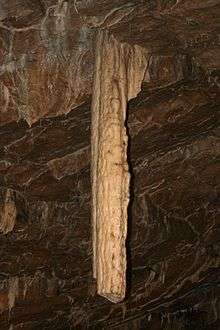Poole's Cavern


Poole's Cavern or Poole's Hole is a two-million-year-old[1] natural limestone cave on the edge of Buxton in the Peak District, in the county of Derbyshire, England.
Pooles Cavern forms part of the Wye system, and has been designated a Site of Special Scientific Interest.[2]
History
The name derives from an outlaw, Poole, who reputedly used the cave as a lair and a base to rob travellers in the fifteenth century.[3] Archeological explorations in 1981 and 1983 have suggested that the cave was occupied from the Bronze Age. Some of the finds have been interpreted as suggesting that one of the chambers was used for religious purposes by Romano-Britons; an alternative explanation is that the cave was a metal-workers' workshop.[4]
Officially opened as a show cave in 1853 by the 6th Duke of Devonshire, the cave was already a tourist attraction, being listed as one of the Wonders of the Peak by Charles Cotton in 1683. Mary, Queen of Scots, is claimed to have been an early visitor. Under the management of the Duke's overseer, Frank Redfern, the entrance was widened and, in 1859, a system of gas lamps was installed to light the caverns (one of the earliest uses of gas in this context), which remained in use until the cave closed in 1965. It reopened in 1976.
Visiting
The region currently open to the public is around 310 metres (1,020 ft) in length, and includes chambers named the Roman Chamber, Great Dome, Poached Egg Chamber and Sculpture Chamber. Features of interest include large stalactites/stalagmites called the Flitch of Bacon and Mary Queen of Scots' Pillar, as well as stalagmites with a porous texture and "poached egg" colour, which has been attributed to minerals leached from lime-burning on Grin Low above.[5] Part of the cavern is accessible to wheelchairs.
The cave system is believed to extend further, but has not been explored.[6] In 1998 a video camera lowered down a borehole revealed the existence of a further chamber, branded "Seventh Heaven".[7]
Commentary
- The writer Daniel Defoe dismissed the cavern as merely "another of the wonderless wonders of the Peak".[8]
References
- ↑ "Geology". Poole's Cavern/Buxton Civic Association Limited. Retrieved 25 May 2012.
- ↑ "Poole's Cavern and Grin Low Wood SSSI: Citation" (PDF). Natural England. Retrieved 10 December 2010.
- ↑ Oldham, T. (2002) History of Poole's Cavern
- ↑ Myers A. An archaeological resource assessment of Roman Derbyshire. The East Midlands Archaeological Research Framework Project
- ↑ Ford, TD. Rocks & Scenery of the Peak District. Landmark Publishing, 2002
- ↑ Natural Curiosities of Derbyshire, in: The Every-day Book and Table Book; or, Everlasting Calendar of Popular Amusements, Sports, Pastimes, Ceremonies, Manners, Customs, and Events, Each of the Three Hundred and Sixty-Five Days, in Past and Present Times; Forming a Complete History of the Year, Months, and Seasons, and a Perpetual Key to the Almanac, Including Accounts of the Weather, Rules for Health and Conduct, Remarkable and Important Anecdotes, Facts, and Notices, in Chronology, Antiquities, Topography, Biography, Natural History, Art, Science, and General Literature; Derived from the Most Authentic Sources, and Valuable Original Communication, with Poetical Elucidations, for Daily Use and Diversion. Vol III., ed. William Hone, (London: 1838) pp. 11–16. Retrieved on 24 June 2008.
- ↑ "Unexplored Chambers". Poole's Cavern/Buxton Civic Association Limited. Retrieved 25 May 2012.
- ↑ Defoe, Daniel (1724–27). "Letter 8, Part 2: The Peak District". A Tour Thro' the Whole Island of Great Britain, Divided into Circuits or Journies. Retrieved 21 June 2012.
External links
| Wikimedia Commons has media related to Poole's Cavern. |
Coordinates: 53°14′59″N 1°55′33″W / 53.2498°N 1.9259°W
